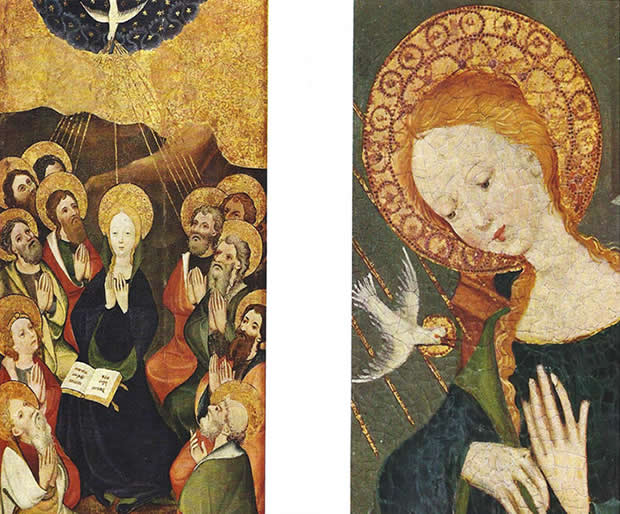A short history of Opus Spiritus Sancti, (OSS)
The Opus Spiritus Sancti (OSS) is the official Latin title for the federation of five individual Communities/Societies founded by Rev. Fr. Bernhard Bendel. In fact, he always rejected to be called the founder of OSS Communities/Societies but rather he would say the founder is the Holy Spirit, I am an instrument. These Communities/Societies are:
- The Apostolic Life Community of Sisters (ALCS).
- The Community of Apostolic Christians (CAC).
- The Secular Institute of Priests (SIP).
- The Secular Institute of Women (SIW)
- The Apostolic Life Community of Priests (ALCP).
When we speak of the Opus Spiritus Sancti (OSS), our minds focus directly on these five Community/Society. It has its own spirituality, goals and mission. These are found in the Communities/Societies and lived in the concrete life of the Church. The members of these different Communities/Societies are members of the OSS or belong automatically to the OSS. They have in common a dedication to the Holy Spirit in their respective Community/Society. All the Communities/Societies participate in the life of the Opus Spiritus Sancti. There is a general Constitution and Directerum Spirituale for all Communities/Societies as well as a Basic Spiritual Exercise. These Communities/Societies are autonomous and independent regarding their administration, the formation of their members, their temporal goods and their specific activities. But all these facts should not hinder the different Community/Society from reflecting upon their individuality.
The Opus Spiritus Sancti has its goals and mission in the Church. These must be communicated to the members, while they are in formation. That all the Communities/Societies are apostolic and secular in character. But the goals and mission depend on the nature of each Community/Society. The formators of each Community/Society in the OSS must understand their own nature and spirituality which should be in the formation of the Church’s doctrine. The application of the goals and mission of the OSS is to participate in the testimony which the Church bears to Jesus Christ.
The Community/Society in the OSS are characterized by unity and solidarity in their basic principles. They are established in different continents but united in the Holy Spirit and in the charism of the founder, Father Bernard Bendel.

The emblem/Logo of Opus Spiritus Sancti (0SS), is portrayed by two pictures as seen above:
- The picture of the Mother of the Church
- The picture of the Mother of Eternal Love
NB: The originals of both pictures are part of a famous Marian altar in the Church of St. Reinoldi in Dortmund, West Germany, painted in the 15th century.
The picture of the Mother of the Church.
The picture of the Mother of the Church was chosen by the founder Fr. Bernhard Bendel as the emblem of the Opus Spiritus Sancti (OSS), to show the action of the Holy Spirit in the lives of Mary and the Apostles at Pentecost. Through the work of the Holy Spirit we, like they were, are filled with a true understanding of the nature of God’s work on earth. We are imbued with zeal and courage and thereby enabled to bring the Good news to all.
Father Bendel envisioned a new Pentecost in our time. As he prayed about this vision he saw the Spirit once again filling the hearts and souls with the Spirit’s fire, so that, like the Apostles in union with Mary they could go into the world spreading the good News and enkindling new fires. He prayed that the Opus Spiritus Sancti might be a modern-day instrument for renewal and for better establishing the Reign of God.
The picture of the Mother of Eternal Love
This picture of “Our Mother of Eternal Love” was chosen by Father Bendel early in the history of the Opus Spiritus Sancti as particularly expressive of the spirituality and the aims of the Opus.
The central point in human history is the Incarnation. The Word of God became flesh and lives among us. The incarnation brings God into union with humankind and expresses God’s love the human family.
As Father Bendel saw the Incarnation, it was not as isolated event in history, but a continuing reality, a making present in every age God’s laving care for all people everywhere. The eternal Word who became Incarnate in the womb of the Virgin Mary continues to become incarnate in those people who are open to the action of the Holy Spirit.
This is precisely the vocation of the Opus Spiritus Sancti: to make this incarnation of God an ever-growing reality in the lives of each member of the Opus and through them to influence all in the world. We are to burn for love of Jesus and others are to be warmed by the burning. Paul’s admonition, “Put on the Lord Jesus Christ” (Romans 13:14) is the daily vocation of the members of the Opus. And we can realize our vocation only by our generous cooperation with the continuing action of the Holy Spirit.
